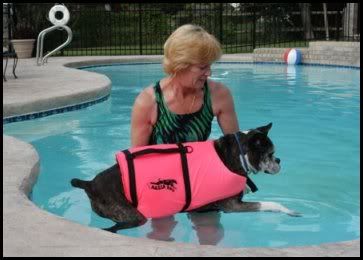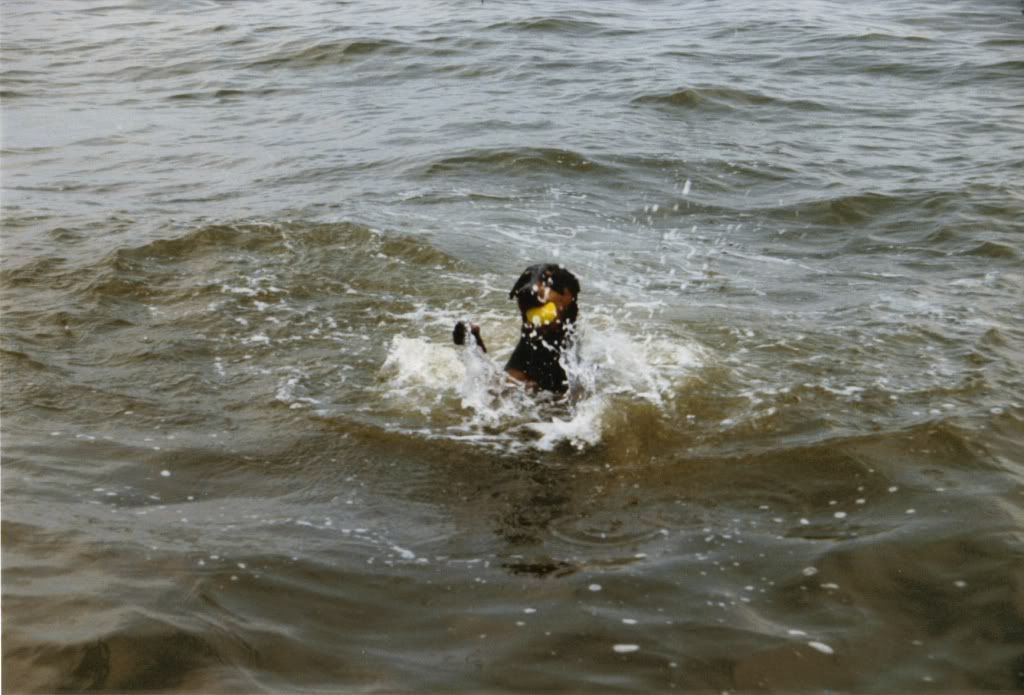Archive for the ‘swim’ Category
by Nancy E. Hassel, LIPetPlace.com
Dog training for Winter safety
Here on Long Island we are so lucky to be surrounded by water, have many lakes, ponds streams and natural areas to enjoy with our pets. Recently after reading a story in Newsday about a Shirley man who’s 2 off leash Husky’s ran after some geese over the thin ice of a pond and fell through. In an effort to save his dogs the owner also fell through into the cold water. The owner admitted it wasn’t too smart, not thinking the ice was too thin or the cold water too deep and found himself in, well, deep water. Thankfully this story has a happy ending where a neighbor happened to hear the man yelling for help and the man and his dogs were all rescued and are all okay. But it made me think, how many people teach their dogs not to go on the ice? It’s not something you think about every day, especially if you get adopt a puppy or dog in the spring, summer or fall. It made me think back to how I taught my first dog, and dog I currently own to be safe near ice.
When I got my first dog as an adult, a young female puppy Doberman in the late summer of 1995, I did a lot of training with her in many different places. One place more than others, happened to be a park with wooded trails, streams and a lake. That first winter, the then 8-month old puppy was very curious about the strange frozen occurrence that the lake had become. While wanting to show her the ice, I also didn’t want her to think it was safe to walk out onto. So without taking a dog training course on winter safety and going on my instincts, I let her sniff the ice, put a front paw or two on it, but never ever let her walk out onto the ice. Using various commands, “off” if she ventured more than one paw onto the ice, or “stay” to keep her by me, or using “eh ah” if she tried to step on it. Of course this was all done while she was on a leash and giving her verbal praise as a reward. I also let her step on a frozen part right near the edge that I knew would break apart, you know those couple inches of water at the edge that freeze but can still be cracked pretty easily – showing her that it would break. Doing this repeatedly throughout the winter months, trained her not to ever step out onto the ice. Each winter after that I would do a refresher near the first frozen body of water we came upon. I was lucky to have one ridiculously smart dog, who learned quickly and seemed to understand the danger. She was also trained to heel, so when in the presence of ducks, geese or any other wildlife she would not chase an animal. Of course a dog being a dog, she still had instincts to want to chase but having her trained on a verbal recall, helped in having to worry if she did get off leash near ice. I did all these same winter training rituals with my current dog, and he too learned quickly, and it didn’t hurt that he was scared of the ice to begin with. (He also learned by watching her not go on the ice.)
You also have to keep in mind what breed of dog you have too. If your dog was specifically bred for hunting, chasing out birds or is a water dog, you still want to teach your dog winter safety training. Just because your have a Chesapeake Bay Retriever doesn’t mean it can get out of a dangerous situation like falling through ice in a middle of a lake.
Winter can be a lot of fun for us and our dogs, but teaching a dog to stay, come on command and never letting your dog off leash near thin or thick ice, are vital to keeping our dogs safe – and ourselves for that matter. Now that the weather is getting cold enough for ice to begin to form across many of our lakes, ponds, and bays – think about training your dog with winter safety in mind. If you are not sure how to do this properly, consult a dog trainer and ask them for a winter safety training session or two.
Another thing a pet owner should know, whether your pet is a dog or a cat is pet first aid and CPR – especially if your pet falls through ice. We are fortunate to have a local certified Pet Tech, Robyn Elman that teaches a class in pet first aid and CPR, including what to do if your pet gets frostbite and hypothermia. The vital information taught in the class has already saved the lives of a few pets of past class participants. These pet owners who knew what to do in an emergency situation, all thanks to the information they learned in Robyn’s class. To find out more information on the upcoming January 22, 2011 class click here. Interested parties should sign up soon, as this course fills up fast and is offered about every six weeks.
June 6, 2010
by Nancy E. Hassel, LIPetPlace.com
Did you know that not all dogs can swim? Most people think that swimming comes naturally to dogs. We have all seen the funny videos of little dogs doing the doggie paddle in the air when held above the bath water by their owners, but that movement doesn’t mean they will be able to swim, stay afloat or tread water.
Being on an Island, dog owners should consider this when out at the beach, near a lake with their dogs, or hanging out by the pool. We are lucky that nowadays there are life jackets made for dogs, scamper ramps to help dogs out of a pool and dog trainers willing to teach dogs to swim. But that doesn’t mean your dog is going to like it or have a swimming technique come naturally to them.
Some things dog owners should never do when trying to get your dog to swim, is force your dog into the water by dragging or throwing a dog in. It’s not only cruel, but can scare a dog or make the dog fearful of water. If you have a puppy, you want to start young introducing the pup to the water, always, always monitored by an adult and never left alone near a body of water. Keep the puppy leashed, and it you have a dog life jacket (properly fitted for the dog’s size), have the puppy wear it. You can get the puppy accustomed to wearing it, by having the dog wear the vest for a few minutes at a time while indoors or on a short walk. While the puppy is leashed you can go into a pool or in the calm water on a shore and just have the pup wade in the water along side of you. Let the dog go in on its own or if you have a dog or friend with a dog that likes the water – that will often help your puppy have less fear.
When teaching the puppy how to swim, make sure that you eventually take the life vest off during lessons for short periods of time, so the dog learns to become buoyant on their own. Owners can assist by helping hold up the dog’s body from the mid to back section of the dog:

Photo, American Boxer Club.
Some dog breeds do take much more naturally to the water as that is what they were bred for. Labs, Goldens, Portuguese Water Dogs, Chesapeake Bay Retrievers, to name a few are natural water dogs, but they still may need help along the way learning. Some breeds are not designed for long swims or swimming at all. My Pit Bull Max, is an excellent swimmer, but his mouth is so wide that he tends to inadvertently swallow a lot of water while swimming. Which can make him sick, so his swim time is never more than 10 to 15-minutes, and that is in and out of the water.
If you are unsure how to teach your dog to swim, the best thing to do is to hire a skilled dog trainer who knows how to do this properly. (Interview the trainer to be sure they know how to teach this). In teaching a dog to swim it’s best to be in the water with the dog as some dogs can panic, and you or the dog trainer can help assist them out.
Another thing to consider is if you are at the ocean beach, be careful of throwing a ball or stick into rough surf – this could easily knock down a dog and injure the dog. Dogs can easily be tossed around by a wave. Some bay beaches have a quick drop off, and if your dog is not used to swimming, a deep drop off can be dangerous. While we all want our dogs to cool off, not every dog is suited to swim. So take steps to enjoy the water with your dog, but safety first!
Writer note: The life jacket can also be a safety precaution while out kayaking or boating with your dog. Also a long line, not a retractable leash, a long leash made of cotton that can be purchased at most pet stores in 10, 15, 25 and 50 in length, is a great tool while teaching a dog to swim. If the dog is over enthusiastic and not on a leash the dog can keep going and going. Believe me I have witnessed this in person. Funny at first, scary when the dog was pretty far out into the bay, luckily for the owner the dog turned and finally headed back. If the owner had a long line, he could have gently pulled the dog back towards the shore.
I owned a Doberman who was not a graceful swimmer at all, and her rear end always tended to sink, so her doggie paddle was more in the air than in the water. She also jumped off the dock once, and we had to coax her around the shore. She did it, but was panicked and exhausted when she came out. While she loved the water, she was smart enough to know her lack of swimming capability and only went out so far (where she could still stand!), not all dogs are that smart!

Don’t let this picture fool you, her back paws were touching here!
And this was clost to the shore of the bay.



Categories
Archives
Blogroll
Meta